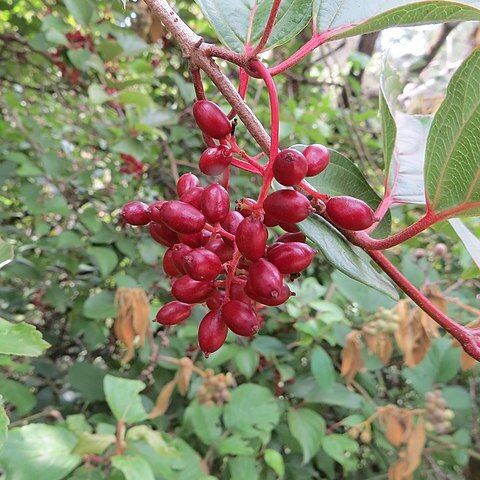Shrubs or small trees, deciduous, to 6 m tall. Bark light brown. Branchlets of current year stellate-pubescent or glabrous; branchlets of previous year gray-brownish or gray-whitish, terete, glabrous, with sparse, dispersed, small, rounded lenticels. Winter buds ovoid-oblong, with 2 pairs of separate scales; scales reddish brown, stellate-pubescent, apex acute. Leaves always opposite, not clustered at apices of branchlets; stipules absent; petiole purplish, robust, 1-2.5 cm, stellate-pubescent or glabrous; leaf blade green when young, elliptic or oblong-lanceolate to narrowly oblong, rarely ovate-cordate or slightly obovate, (2-)6-14 × 1-9 cm, papery, abaxially stellate-pubescent on midvein and lateral veins, adaxially glabrous or pubescent on midvein, midvein raised abaxially, lateral veins 4-9-jugate, pinnate, slightly arched, branched, mostly ending in teeth, raised abaxially, impressed adaxially, veinlets transverse, slightly impressed on both surfaces, not lobed, base cuneate or obtuse to rounded or cordate, without glands, margin serrulate except at base, apex acuminate or acute to obtuse. Flowers appearing with leaves; inflorescence paniculate, at apices of short branchlets with 1-jugate leaves, usually nodding, (5-)7.5-10 × 3-4 cm; rays opposite, decussate; first node of inflorescence with 2 rays, lax, stellate-pubescent or subglabrous, without large sterile radiant flowers; peduncles 2-6 cm; bracts caducous, leaflike, reddish, linear to linear-lanceolate, glabrous; bracteoles linear. Flowers on rays from 1st to 3rd orders, fragrant, sessile or shortly pedicellate. Calyx reddish; tube tubular, 2.5-3 mm, usually glabrous, sometimes with tiny red-brown glands; lobes ovate-triangular, very small, ca. 0.5 mm, glabrous or stellate-pubescent, apex obtuse. Corolla white tinted pink outside, or pink, hypocrateriform, ca. 8 mm in diam., glabrous; tube 5-6 mm; lobes spreading, ovate, 2-3.5 mm, apex rounded, margin entire. Stamens shorter than corolla, inserted at apex of corolla tube; filaments very short; anthers yellow-whitish, slightly exserted, ca. 1 mm. Styles exceeding calyx lobes; stigmas capitate. Fruit maturing purple-reddish, later nigrescent, ellipsoid, 6.5-8.5 × 4.5-6 mm, base rounded, apex rounded, glabrous; pyrenes compressed, obovoid, 7-9 × 4-5 mm, with 1 broad and deep ventral groove, apex rounded. Fl. Apr-Jun, fr. Aug. 2n = 48, 64.
More
A tree. It grows to about 6 m high. It spreads 3 m wide. The leaves have stalks. They are opposite. The leaves are 2-13.5 cm long by 1-6.5 cm wide. They are oblong and taper to the tip. There are teeth along the edge. They are hairy underneath. The flowers are white or pinkish. The fruit is fleshy with a hard covering over the seed. It is oval and red.

